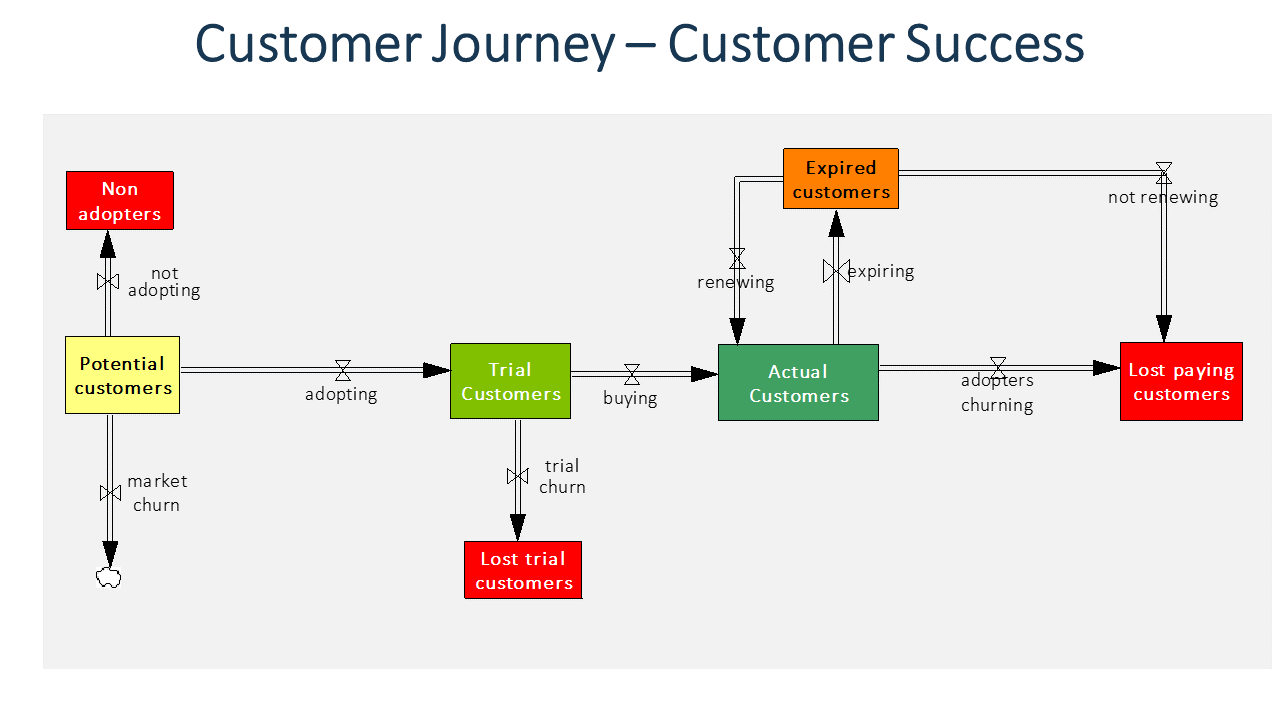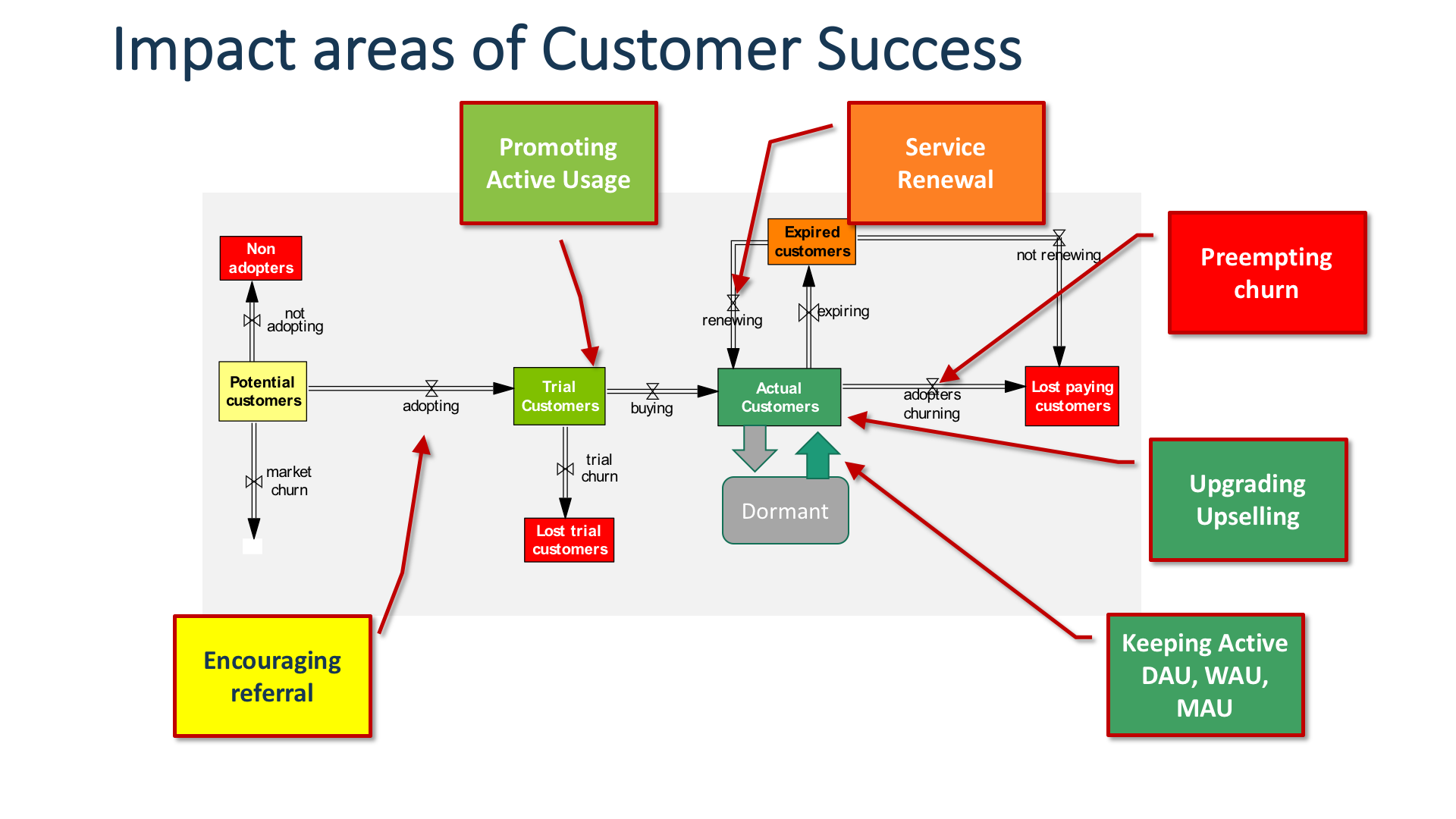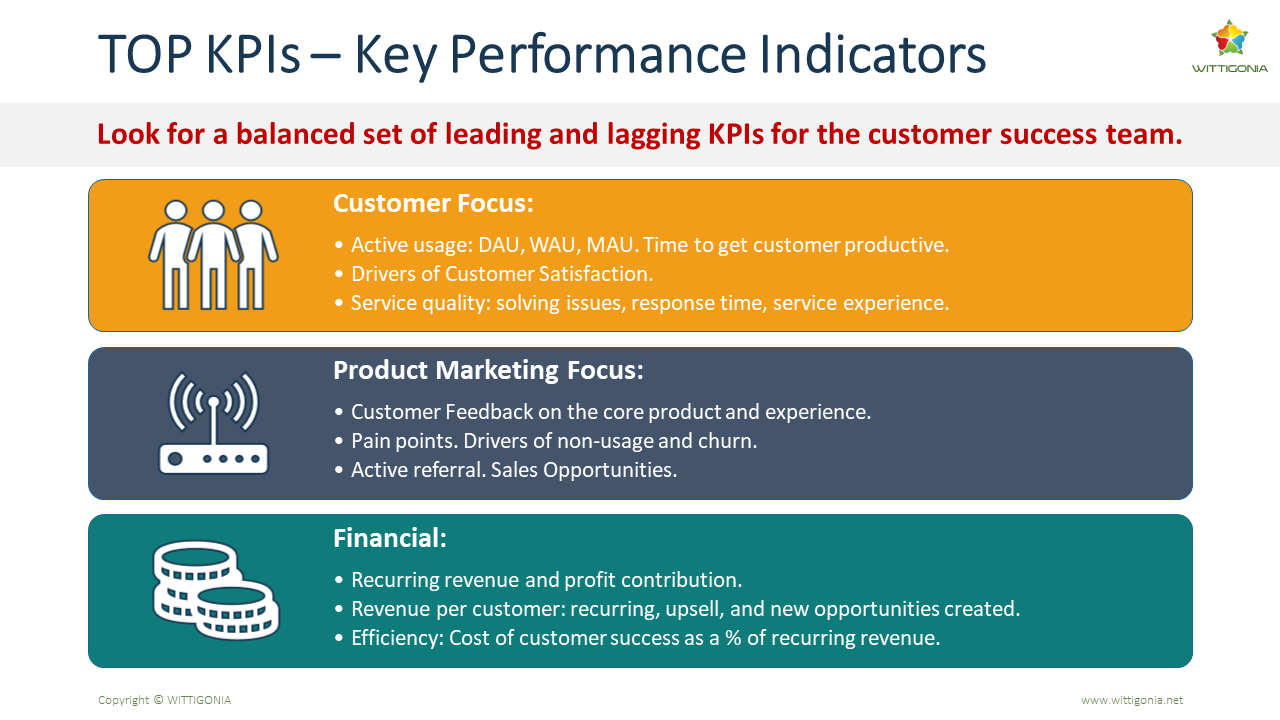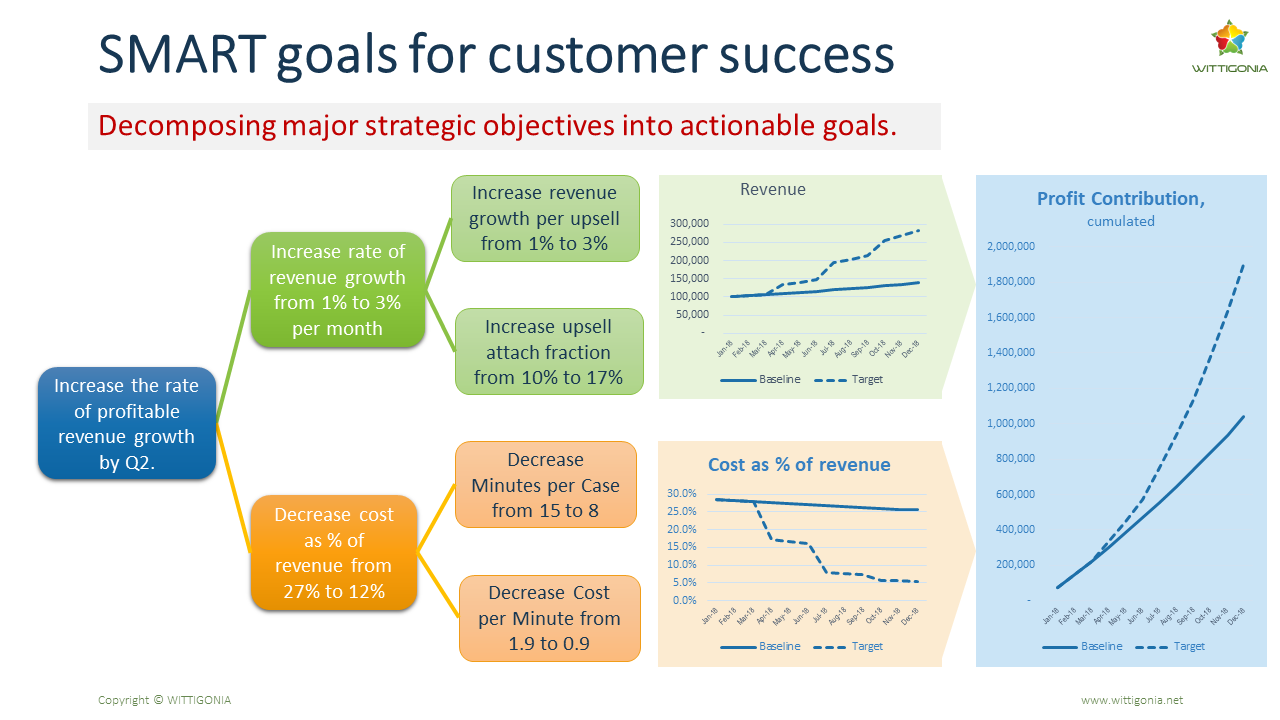Customer Success Management KPI
How to set smart objectives for your customer success team?
The mission and purpose of a customer success team is to keep the customers active and productive, to retain customer and to sustain and grow recurring revenue.
More importantly:
Customer Success can have a compounding effect on your new sales and new revenue growth in addition to recurring revenue.
This is an aspect which is often overlooked when making budget and staffing decisions about customer success. We will get back to this later in this post.
In this blog post and related video, we will talk more about SMART objectives and KPIs for Customer Success.
- What are the focus areas for Customer Success?
- Where can Customer Success make an impact on the objectives and key results?
- And which KPIs should be on your management dashboard?
- How to set “SMART” objectives and goals for customer success?
In an earlier blog post and video, I talked about SMART objectives for marketing and how to define more specific goals. The topics are related. But since customer success is usually more focused on downstream focus areas, specifically the customer base growth, it is worthwhile taking a closer look. And let’s remind ourselves:
Increasing revenue from existing happy customers is easier than winning new customers.
Related Video
Watch this video to learn more about SMART Objectives and Goals for Customer Success. Scroll down to continue reading.
The WITTIGONIA YouTube channel provides more videos with ideas for marketing, innovation, transformation and growth. Take a moment to subscribe to the channel. It’s free! You will receive notification about new videos.
Related Podcast Episode
Listen to the episode from the idea,- podcast. The podcast is available on many popular plattorms. And it is FREE!
Podcast Episode
Listen here and on popular podcast platforms for free.
What does SMART goal stand for?
The acronym "SMART" stands for characteristics of a well defined SMART objective:
- S stands for "specific"
- M stands for "measureable"
- A stands for "achieveable" (sometimes also referred to as "accountable")
- R stands for "realistic"
- T stands for "timely" or "time bound".
SMART goals should of course not only be defined for customer success or customer service. They should be embedded in a management system which enables the organisation to set, review, refine and achieve goals. That requires, that other business functions need to have SMART goals as well. Furthermore, it requires manager to be able to set and review performance according to SMART objectivs.

Customer Success Journey
Before customers enter the realm of the Customer Success Team, they have gone through a journey from being a potential customer, considering the product, trying the product and finally making a purchase.

Customer Journey
Areas of Impact for Customer Success
But when you are leading a customer Customer Success Team you have probably found out a way to engage with customers much earlier. The ongoing customer experience is a key factor in keeping customers. And therefore it is better if you provide the exceptional customer experience very early in the customer journey.
The primary charter of the Customer Success Team is to ensure that customers get the most out of the product or service.
And beyond this core focus there a several areas where Customer Success can help drive revenue growth and become an important part for the growth strategy and tactics, e.g. for a SaaS product.

Impact areas of Customer Success
What are the areas of impact for Customer Success?
Promoting the active trial usage of the product.
Only customers who are actually using the product have a higher likelihood of purchasing. A key risk is customers become “dormant” already in the trial phase. Preventing this flow of customers becoming inactive is low hanging fruit for the Customer Success Team.
Active usage of the product of customers who have purchased.
In service-oriented businesses where human interaction is required to deliver the service it may sound a bit counter-intuitive. More interaction means higher cost of delivery and lower margins. But in the longer run it will pay off. Only customers who experienced the benefit of the service are more likely to renew the subscription.
Upselling and upgrading existing customers is usually easier.
The customer acquisition cost (CAC) of bringing in net new customers is usually higher than upselling and retaining existing clients.
Encouraging recommendations and supporting word-of-mouth promotion through existing happy customers can be a key growth tactic.
For example, you can offer existing clients additional free services, discounts our even a referral bonus. This is especially interesting in services and products which are related to social and professional networks. If your top 100 clients have 100 LinkedIn contacts each on average then this a great referral opportunity to tap into.
And last but not least:
Customer Success has great opportunity to prevent churn.
There are at least 3 main potential flows of churning customers:
- Customers who have tried the product or are dormant trial customers.
- Those customers with upcoming renewal of the service or subscription or which have exceeded renewal date but have not yet cancled.
- And customers who are not renewing (“lost customers”).
Each one of these cohorts has different history and motivation. And it is important to find out what is driving their intent to renew or purchase. Getting this information through product insights, conversations and survey with sufficient lead time is essential to retaining customers.
KPIs and for smart customer success objectives
Building on these opportunities for customer success you can design your management KPI dashboard. Make sure to have a balanced set of KPIs and a mix of leading (e.g. usage, satisfaction) and lagging indicators (e.g. churn, revenue).
The KPI dashboard for Customer Success should include the stocks of customers, the inflows and outflows from this stock and the parameters which determine the flow rates. This enables you to understand and design the business dynamics of customer success operations.

KPI dashboard for Customer success
Defining SMART objectives for customer success managers
Example
It is important to align the KPIs to the job roles. In other words, make sure that every person on the team can actually move the needle on their KPI. This may require decomposing the KPIs in to smaller chunks which can be managed and controlled by the contributors.
Assume you are the manager who is responsible for customer success. And your given charter and goal is
“…to increase profit contribution from customer success”.
This is a fairly generic and even vague goal. It could mean anything and the timeframe to accomplish the goal is not clear. Also, it is not clear how you will accomplish this goal? Where to start? Which levers to pull?
Decomposing goals helps your SMART goal definition
One way to make this goal more specific and to translate it into a set of SMART goals is to clarify and refine the goal and decompose it into more manageable objectives.
You can start with clarifying the situation and intent:
“We have a target of 1.8M in revenue from customer success. This represents an 80% increase from our baseline projection”.
And:
“If we continue with the current rate of growth, then our performance will fall short.”
Define the required changes and break it into more manageable chunks:
“To accomplish the goal, it is necessary to increase rate of growth of recurring revenue from 1% to 3% per month by Q2”
And
“Reduce the cost of customer success as a % of recurring revenue from 27% to 12% by Q4, starting in Q2.”

Example goal sheet of SMART goals for customer success.
How SMART objectives help you manage performance, experience and satisfaction
This accomplishes a number of things:
First, it makes clear which portion of the revenue and profit contribution we are talking about. In other words, we have a better alignment to the overall picture. Secondly, the goals are now specific, measurable, actionable, realistic and time specific.
But what is driving the cost of customer success? And can you really influence it? If the revenue opportunity and cost is driven to a large degree by inbound requests from customers who have questions about getting started, then the picture looks a bit more differentiated.
The cost per case (customer requests) is a result of time per case and cost per minute spend on the case.
Cost per case = Minutes per Case * Cost per Minute
As customer success manager you can control the minutes per case to some degree by hiring strategies, training, having the right tools and knowledge management. But it is also dependent on the product. This is an area where at least a shared objective between customer success and product development would be in order.
The cost per minute is a matter of hiring, compensation policy, vendor selection and location strategies. All of these should be in your control if you are empowered to make these decisions. And these are usually strategic decision which is hard to revise. They require through planning and good forecasting.
The resulting roadmap for your SMART objectives could look something like this:

Decomposing a main goal into manageable smart objectives.
With this example we have gone into much detail. But it illustrates the kind of consideration and discussion which should happen before setting and committing to smart objectives.
Conclusion
Setting SMART objectives is a great leadership tool for delivering excellent customer success experience and performance.
Make sure to decompose the overall main objective into manageable chunks which can be accomplished by the team members. These components need to add up to the overall desired outcome.
Establish a cadence of informed dialogues about performance and progress with your team. A well composed and balanced KPI dashboard is key to keep the team aligned and adjust focus areas and resource allocation as you move forward.
Related Material
Check out out podcast which is available on popular platforms such as Apple, Google, Spotify and more.
In a related post we will talk about setting and prioritising SMART goals under uncertainty. This has become a major topic for many organisations as the budgets get tighter and the world around us is becoming more volatile, complex and uncertain.
Let's stay in touch!
Subscribe to our Newsletter and stay in touch and informed.
You can change your preferences or unsubscribe at any time. We respect your privacy and and data protection. Please read more in our Data Privacy Declaration.
